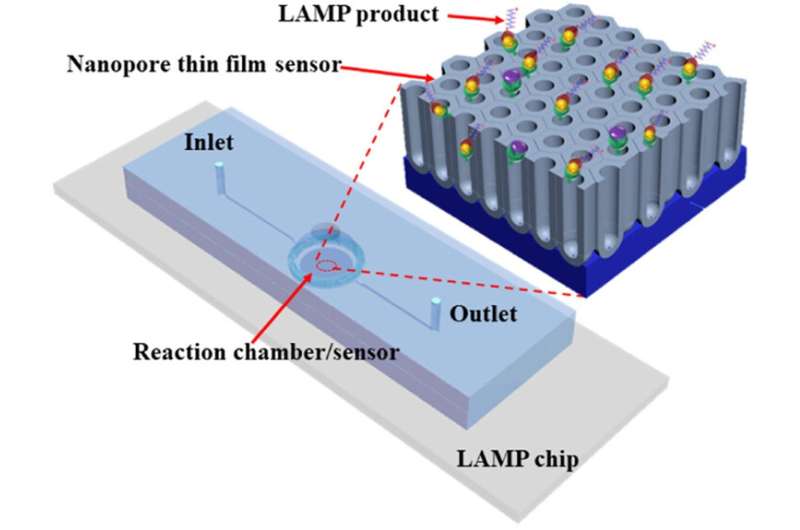This article has been reviewed according to Science X's editorial process and policies. Editors have highlighted the following attributes while ensuring the content's credibility:
fact-checked
peer-reviewed publication
trusted source
proofread
New sensor chip advances rapid, cost-effective disease diagnostics

Texas A&M AgriLife Research scientists and collaborators at Iowa State University have developed a sensor chip that can detect many disease pathogens with 10 times the sensitivity of currently available methods.
The chip also eliminates the need for chemical dye reagents typically used in the diagnostic process. The new technology shows promise for rapid, low-cost point-of-care diagnostic capabilities in plants, foods, animals and humans, including detecting foodborne pathogens, bird flu and COVID-19.
Results from the new sensor are available in about 30 minutes.
In their research, published in ACS Sensors, scientists used the new sensor to detect Phytophthora infestans. The pathogen causes globally devastating late blight disease—a particular threat to potato and tomato crops.
The research was co-led by Jinping Zhao, Ph.D., AgriLife Research postdoctoral research scientist in Dallas, and Subin Mao, a Ph.D. candidate in electrical and computer engineering at Iowa State University. Serving as corresponding authors were collaborators Junqi Song, Ph.D., associate professor and plant immunity research lead with AgriLife Research in Dallas, and Long Que, Ph.D., professor of electrical engineering at Iowa State University.
"This research advances technologies that have emerged as some of our greatest opportunities for improving agriculture, food safety and human health," Song said. "Our publication represents a step toward realizing these powerful tools against diseases."
Building on existing technologies
The new sensor improves upon a technique known as loop-mediated isothermal amplification, or LAMP, which is widely used to detect pathogens by amplifying their DNA.
Detection of LAMP products amplified from templates, such as pathogen DNA, often requires that the products be "labeled" by using fluorescence dyes—a costly process with low sensitivity. The new sensor diagnoses pathogens without such reagents and at high sensitivity. It also eliminates a lengthy DNA purification process that creates challenges for point-of-care use.
The new chip consists of a nanopore thin-film sensor inside a special reaction chamber. Primers are uniquely designed to be immobilized on the nanofilm, causing amplified LAMP products to become bound to the sensor, which produces signals that can be directly and easily measured with a portable spectrometer.
What's next
The LAMP chip offers a new portable platform to detect pathogens using label-free sensors with ultrasensitivity. The research team will now work to further enhance sensitivity to a subattomolar or even lower level.
The team aims to offset current challenges to detecting and distinguishing pathogen species and strains with high-sequence similarities. They will also work to improve the specificity of detections and establish quantitative detection by integrating artificial intelligence and CRISPR gene-editing technologies.
Their goal is to achieve a viable product for broad adoption in plant, animal and human health point-of-care applications.
More information: Subin Mao et al, Integrated Sensing Chip for Ultrasensitive Label-Free Detection of the Products of Loop-Mediated Isothermal Amplification, ACS Sensors (2023). DOI: 10.1021/acssensors.3c00227
Journal information: ACS Sensors
Provided by Texas A&M University





















